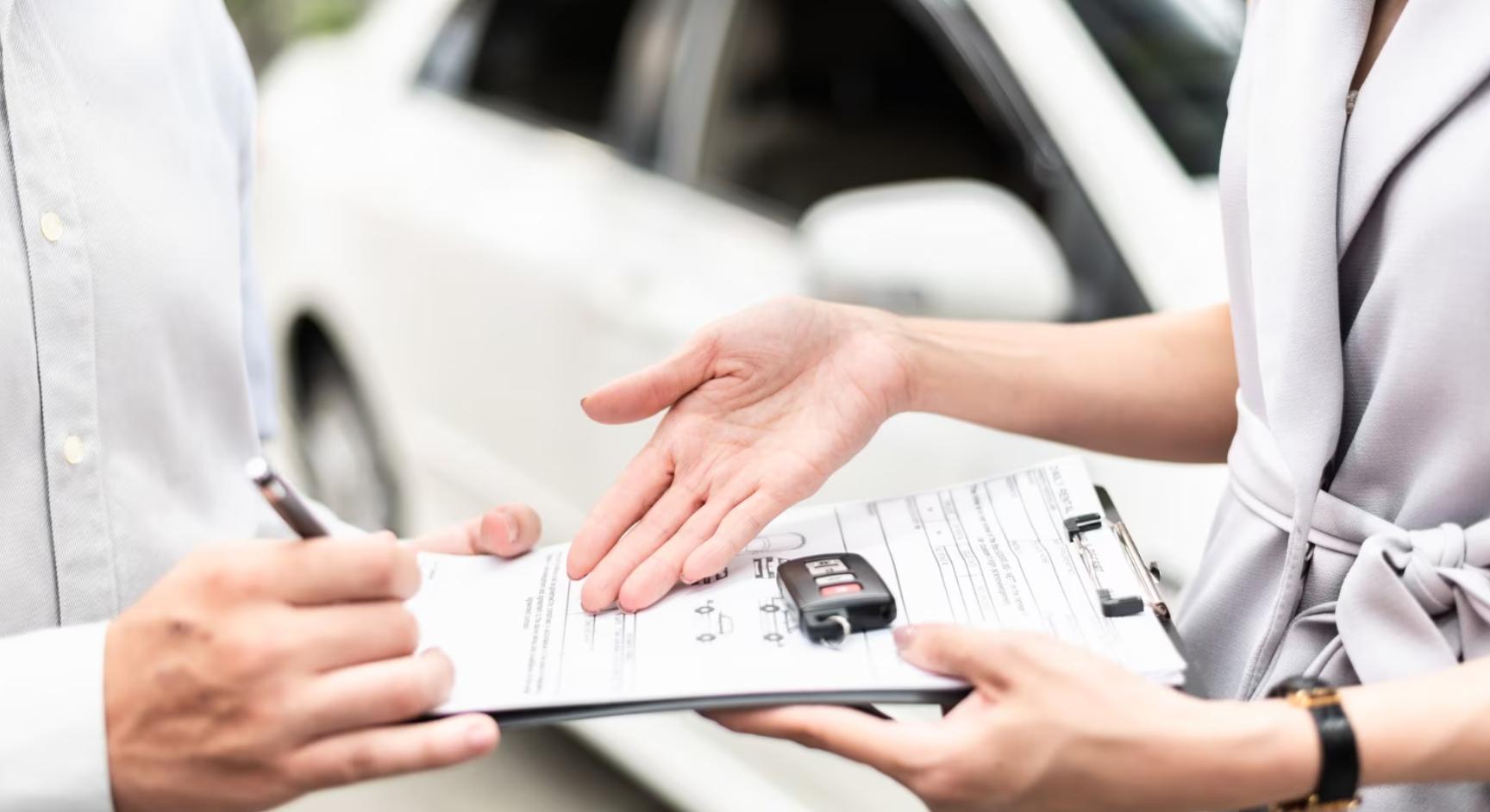
Guide To Leased Car Insurance: Leasing a car comes with its own set of insurance requirements and considerations. Understanding the ins and outs of leased car insurance can help you make informed decisions and ensure you have the right coverage for your leased vehicle.

How to Handle Insurance Claims for Leased Vehicles
Leasing a car can be a convenient and cost-effective option for many drivers. However, when it comes to insurance, there are some important considerations to keep in mind. In this guide, we will discuss how to handle insurance claims for leased vehicles.
One of the first things to understand is that leased cars typically require a higher level of insurance coverage than owned vehicles. This is because the leasing company is the legal owner of the car, and they want to protect their investment. Most leasing companies require drivers to carry both comprehensive and collision coverage, in addition to the state-mandated liability coverage.
In the event of an accident, it is important to notify your insurance company as soon as possible. They will guide you through the claims process and help you determine what coverage applies to your specific situation. It is also a good idea to notify the leasing company of the accident, as they may have specific requirements for reporting incidents involving their vehicles.
When filing a claim for a leased vehicle, it is important to provide all necessary documentation to your insurance company. This may include a copy of the police report, photos of the damage, and any other relevant information. Your insurance company will work with the leasing company to assess the damage and determine the appropriate course of action.
If your leased vehicle is deemed a total loss, your insurance company will typically pay the leasing company the actual cash value of the car. However, if the amount owed on the lease is greater than the actual cash value, you may be responsible for paying the difference. This is where gap insurance can be helpful, as it covers the “gap” between what you owe on the lease and what the insurance company pays out.
It is also important to understand that any modifications or upgrades made to a leased vehicle may not be covered by insurance. If you have added aftermarket parts or made other changes to the car, it is a good idea to discuss this with your insurance company to ensure that you have the appropriate coverage.
In some cases, the leasing company may require you to use a specific repair shop for any repairs to the vehicle. This is known as a “preferred provider” arrangement, and it is important to follow these guidelines to avoid any potential issues with the lease agreement.
Overall, handling insurance claims for leased vehicles requires careful attention to detail and communication with both your insurance company and the leasing company. By understanding the requirements and potential pitfalls of insuring a leased car, you can ensure that you are adequately protected in the event of an accident. Remember to review your insurance policy regularly and make any necessary adjustments to ensure that you have the coverage you need.
Common Mistakes to Avoid When Insuring a Leased Car
Leasing a car can be a convenient and cost-effective option for many drivers. However, when it comes to insuring a leased vehicle, there are some common mistakes that drivers often make. In this guide, we will discuss some of these mistakes and provide tips on how to avoid them.
One of the most common mistakes that drivers make when insuring a leased car is not purchasing enough coverage. When you lease a car, the leasing company will typically require you to carry a certain level of insurance coverage to protect their investment. This usually includes liability insurance, which covers damages to other people and property in the event of an accident. However, it is important to also consider purchasing comprehensive and collision coverage to protect your own vehicle in the event of an accident or other covered event.
Another common mistake that drivers make when insuring a leased car is not understanding the terms of their lease agreement. It is important to carefully review your lease agreement to understand what insurance coverage is required and what is optional. Some leasing companies may require you to carry gap insurance, which covers the difference between the value of the car and the amount you owe on the lease in the event of a total loss. It is important to understand these requirements and make sure you have the appropriate coverage in place.
One mistake that drivers often make when insuring a leased car is not shopping around for the best rates. Many drivers simply renew their existing insurance policy without comparing rates from other insurance companies. By shopping around and comparing quotes from multiple insurers, you may be able to find a better rate and save money on your insurance premiums. It is important to consider factors such as the level of coverage, deductibles, and any discounts that may be available when comparing insurance quotes.
Another common mistake that drivers make when insuring a leased car is not updating their insurance policy when their lease agreement changes. If you make any changes to your lease agreement, such as adding or removing a co-signer, it is important to update your insurance policy to reflect these changes. Failure to do so could result in gaps in coverage or even a cancellation of your policy. It is important to review your insurance policy regularly and make any necessary updates to ensure that you have the appropriate coverage in place.
In conclusion, insuring a leased car can be a complex process, but by avoiding these common mistakes and following the tips outlined in this guide, you can ensure that you have the appropriate coverage in place to protect your investment. By purchasing enough coverage, understanding the terms of your lease agreement, shopping around for the best rates, and updating your policy as needed, you can avoid costly mistakes and enjoy peace of mind knowing that you are adequately protected.
Tips for Saving Money on Leased Car Insurance
Leasing a car can be a convenient and cost-effective option for many drivers. However, one important aspect of leasing a car that is often overlooked is the need for proper insurance coverage. Leased car insurance is a requirement for most leasing agreements, and it is important to understand the ins and outs of this type of insurance to ensure that you are adequately protected while also saving money.
When it comes to leased car insurance, there are a few key things to keep in mind. First and foremost, it is important to understand the different types of coverage that are available. Most leasing agreements will require you to have both comprehensive and collision coverage, which will protect you in the event of an accident or other damage to your leased vehicle. Additionally, you may also want to consider adding on additional coverage such as gap insurance, which can help cover the difference between what you owe on your lease and the actual cash value of the vehicle in the event of a total loss.
One of the best ways to save money on leased car insurance is to shop around and compare quotes from multiple insurance providers. Different insurance companies may offer different rates for the same coverage, so it is important to do your research and find the best deal for your specific needs. Additionally, many insurance companies offer discounts for things like bundling multiple policies, having a good driving record, or taking a defensive driving course, so be sure to ask about any potential discounts that may be available to you.
Another way to save money on leased car insurance is to consider increasing your deductible. A higher deductible means that you will have to pay more out of pocket in the event of a claim, but it can also lower your monthly insurance premiums. Before increasing your deductible, however, be sure to consider whether you will be able to afford the higher out-of-pocket costs in the event of an accident.
It is also important to review your leased car insurance policy regularly to ensure that you are getting the best coverage at the best price. As your driving habits and circumstances change, your insurance needs may also change, so it is a good idea to review your policy at least once a year to make sure that you are still adequately protected. Additionally, if you have made any significant changes to your leased vehicle, such as adding aftermarket modifications or upgrading to a newer model, be sure to update your insurance policy accordingly to ensure that you are fully covered.
In conclusion, leased car insurance is an important aspect of leasing a vehicle that should not be overlooked. By understanding the different types of coverage available, shopping around for the best rates, and taking advantage of discounts and other cost-saving measures, you can ensure that you are adequately protected while also saving money on your leased car insurance. Be sure to review your policy regularly and make any necessary updates to ensure that you are getting the best coverage at the best price.
Comparing Different Insurance Options for Leased Vehicles
Leasing a car can be a convenient and cost-effective option for many drivers. However, one important aspect to consider when leasing a vehicle is insurance coverage. Leased car insurance is different from regular car insurance, and it’s essential to understand the specific requirements and options available to ensure you are adequately protected.
When leasing a car, the leasing company will typically require you to carry a certain level of insurance coverage. This is to protect their investment in the vehicle in case of an accident or other damage. The most common types of insurance coverage required for leased vehicles are liability insurance, collision insurance, and comprehensive insurance.
Liability insurance is the most basic type of insurance coverage required for leased vehicles. This coverage protects you in case you are at fault in an accident and cause damage to another person’s property or injure someone. It is essential to carry liability insurance to comply with state laws and leasing company requirements.
Collision insurance is another important type of coverage for leased vehicles. This coverage protects you in case your leased vehicle is damaged in a collision with another vehicle or object. Collision insurance will cover the cost of repairs or replacement of the leased vehicle, up to the policy limits.
Comprehensive insurance is a more comprehensive type of coverage that protects you in case your leased vehicle is damaged by something other than a collision, such as theft, vandalism, or natural disasters. Comprehensive insurance provides coverage for a wide range of perils and can give you peace of mind knowing that you are protected in various situations.
When comparing different insurance options for leased vehicles, it’s essential to consider the coverage limits, deductibles, and premiums of each policy. The coverage limits determine the maximum amount the insurance company will pay out in case of a claim, while the deductible is the amount you will have to pay out of pocket before the insurance coverage kicks in.
Premiums are the amount you pay for the insurance coverage, typically on a monthly or annual basis. When comparing insurance options, it’s essential to consider not only the cost of the premiums but also the level of coverage provided. It’s important to strike a balance between affordability and adequate protection to ensure you are adequately covered in case of an accident or other damage to your leased vehicle.
In addition to the required insurance coverage, you may also want to consider adding optional coverages to your leased car insurance policy. Optional coverages such as rental reimbursement, roadside assistance, and gap insurance can provide additional protection and peace of mind in various situations.
Rental reimbursement coverage will cover the cost of a rental car if your leased vehicle is in the shop for repairs after an accident. Roadside assistance coverage provides assistance in case of a breakdown or other roadside emergency, such as a flat tire or dead battery. Gap insurance covers the “gap” between the actual cash value of your leased vehicle and the amount you owe on your lease in case of a total loss.
Overall, when comparing different insurance options for leased vehicles, it’s essential to consider the required coverage, optional coverages, and premiums of each policy. By understanding your insurance needs and comparing different options, you can choose the right insurance coverage for your leased vehicle and ensure you are adequately protected in various situations.
Understanding the Basics of Leased Car Insurance
Leasing a car can be a convenient and cost-effective option for many people. However, it’s important to understand the insurance requirements that come with leasing a vehicle. Leased car insurance is a bit different from regular car insurance, so it’s essential to know what you need to protect yourself and your investment.
When you lease a car, the leasing company technically owns the vehicle, which means they will require you to have specific insurance coverage. The most common type of insurance required for leased cars is comprehensive and collision coverage. This type of coverage will protect the vehicle in case of an accident, theft, or damage.
In addition to comprehensive and collision coverage, leasing companies may also require you to have liability insurance. Liability insurance covers damages to other people or property in the event that you are at fault in an accident. This type of coverage is typically required by law in most states, so it’s essential to make sure you have the appropriate amount of liability coverage for your leased vehicle.
Another important aspect of leased car insurance is gap insurance. Gap insurance covers the difference between the actual cash value of the vehicle and the amount you owe on the lease in the event that the car is totaled or stolen. This type of insurance can be crucial, as it can protect you from having to pay out of pocket for the remaining balance on the lease if something happens to the vehicle.
It’s also important to note that leased car insurance requirements may vary depending on the leasing company and the terms of your lease agreement. Some leasing companies may have specific insurance requirements that go beyond the standard coverage, so it’s essential to review your lease agreement carefully and make sure you have the necessary coverage.
When shopping for leased car insurance, it’s a good idea to compare quotes from multiple insurance companies to ensure you’re getting the best coverage at the best price. Be sure to provide accurate information about your leased vehicle, driving history, and coverage needs to get an accurate quote.
In addition to shopping around for insurance quotes, it’s also a good idea to ask your leasing company for recommendations on insurance providers. They may have preferred insurance companies that offer discounts or special rates for leased vehicles.
Overall, understanding the basics of leased car insurance is essential for protecting yourself and your investment. Make sure you have the appropriate coverage required by your leasing company, including comprehensive and collision coverage, liability insurance, and gap insurance. Shop around for quotes and consider asking your leasing company for recommendations on insurance providers. By taking the time to understand and secure the right insurance coverage for your leased vehicle, you can drive with peace of mind knowing you’re protected in case of an accident or other unforeseen events.
Conclusion
In conclusion, it is important for individuals who lease a car to carefully review and understand their insurance coverage options. By considering factors such as liability coverage, comprehensive and collision coverage, and gap insurance, lessees can ensure they are adequately protected in the event of an accident or other unforeseen circumstances. It is recommended to consult with an insurance agent or provider to determine the best coverage options for a leased vehicle.





